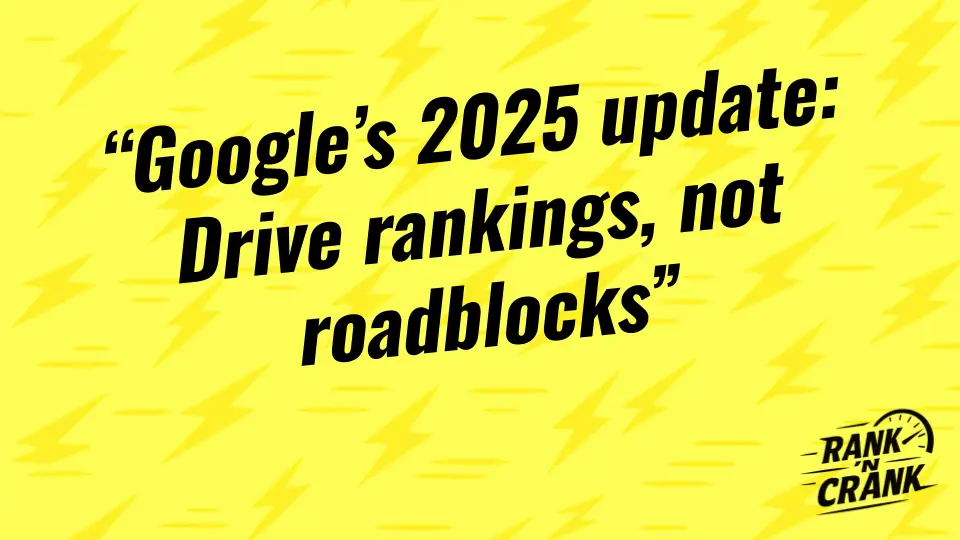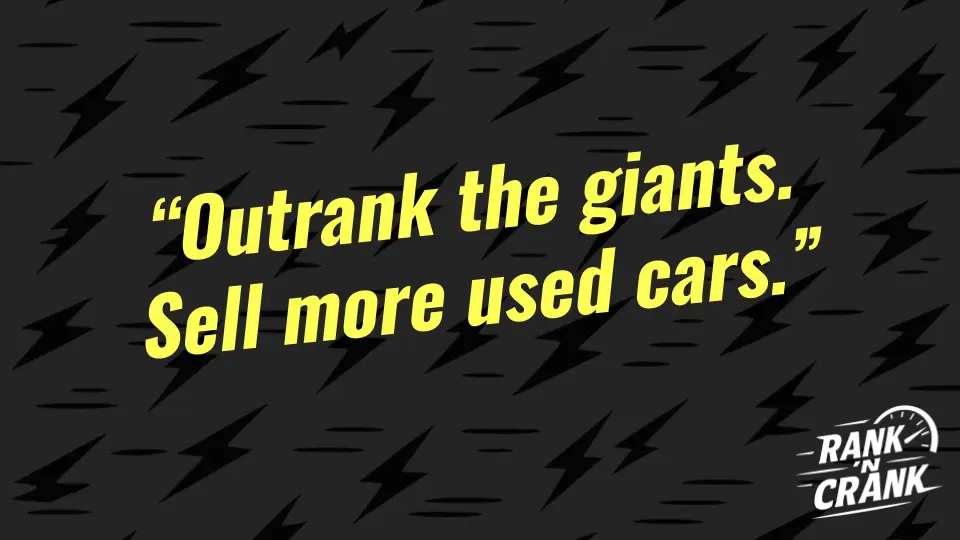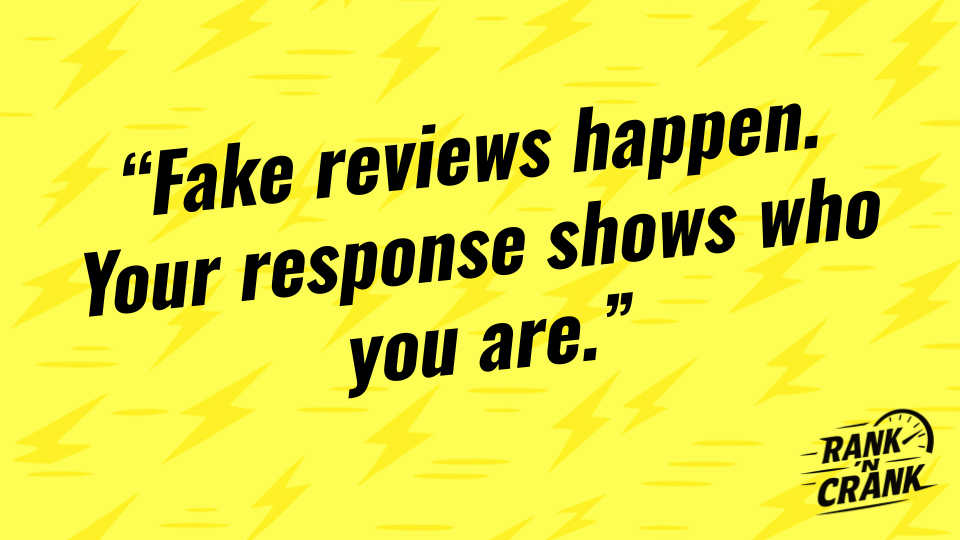The Local SEO Playbook for Car Dealers in High-Competition Markets
Showing up for the right local searches is how you win more leads—and stop bleeding sales to your competitors.
Don’t have time to read all this?
Here’s the short version:
If you’re in a metro or dealership-heavy area, surface-level SEO won’t get you seen—let alone clicked. These local SEO tips are built to help car dealers outrank the competition, especially in saturated markets.
Build unique landing pages for each service area—no copy/paste junk
Post weekly to your Google Business Profile and respond to reviews
Use schema, earn real local backlinks, and target hyperlocal search terms
Anchor content to real local events and buyer intent
Refresh old pages with location-specific value
In metro areas or dealership-dense towns, everyone’s fighting for the same map pack real estate. The difference between being #2 and #6 in local results? Hundreds of leads a month.
And let’s be real—most dealers are relying on outdated strategies, templated content, or agencies who haven’t touched their local signals in months. If you want to win, you’ve got to stop phoning it in and get tactical.
These strategies go deeper than “optimize your meta tags.” They’re designed to help your dealership rise through the ranks in your exact service area—not some hypothetical market.
1. Create Location-Specific Landing Pages That Don’t Suck
Don’t build a dozen carbon-copy pages with city names swapped out—that’s lazy and won’t rank. Build unique, useful content for each area you serve. Include:
Local inventory highlights
Service area-specific specials
Internal links to relevant pages (finance, trade-in, service)
Photos from your lot or staff delivering to that location
References to landmarks, highways, or neighborhoods customers recognize
Pro Tip: Google wants location relevance and helpful content. If it doesn’t help the user, it won’t help your rankings.
2. Treat Your Google Business Profile Like a Second Website
Your GBP is often the first thing people see. Yet most dealers let it rot.
Instead:
Post updates at least weekly (specials, promotions, events, holiday hours)
Add UTM tags to your website links to track performance
Choose the right primary and secondary categories
Regularly update photos—inventory, team, service center, lot
Ask for reviews consistently and reply to every single one
GBP isn’t optional. It’s your #1 local ranking signal. Own it.
3. Build Local Backlinks That Actually Matter
Forget buying links or paying for placements on shady blogs. Instead, earn links that prove your authority locally:
Sponsor a little league team or local 5K? Ask for a link.
Partner with a nonprofit? Get on their supporters page.
Get interviewed by a local publication? That’s gold.
Join your chamber of commerce or a local dealer group with a public directory.
Even 5–10 legit local backlinks can move the needle in your map rankings.
4. Use Local Business Schema (and Use It Right)
Schema markup helps search engines understand your business location, services, and structure. But don’t just slap it on your homepage.
Here’s what to mark up:
Your address, phone, and hours (with
LocalBusinessschema)Reviews and star ratings
Service pages using
ProductorServiceschemaDepartment-level schema for parts, service, or finance if you have unique pages for each
Make sure your schema matches exactly what’s shown on your GBP and on-page content. Inconsistencies hurt.
5. Create Content Around Real Local Events and Partnerships
Everyone wants to rank for “[brand] dealer.” But real shoppers use specific, intent-based searches like:
“Certified pre-owned Accord under 20k near [neighborhood]”
“Lease deals on trucks in [zip code]”
“Oil change coupons [city]”
Use tools like Google Search Console, GMB Insights, or even on-site search data to find what your customers are actually typing in—then build content for it.
6. Target Hyperlocal Keywords with Intent
Everyone wants to rank for “[brand] dealer.” But real shoppers use specific, intent-based searches like:
“Certified pre-owned Accord under 20k near [neighborhood]”
“Lease deals on trucks in [zip code]”
“Oil change coupons [city]”
Use tools like Google Search Console, GMB Insights, or even on-site search data to find what your customers are actually typing in—then build content for it.
7. Refresh Old Content with Local Angles
That blog post from 2022 about “Best First Cars for Teens” still has life—but only if you give it new relevance.
Try:
Adding local pricing and inventory references
Calling out local schools, driving conditions, or licensing rules
Linking to updated landing pages with active CTAs
Re-optimizing for zip code-level keywords or “near me” phrasing
🛠️ If Google sees your content as fresher, more relevant, and better tied to local search, you’ll gain ground on stale competitors.
Final Word: You Can’t Win with Basic SEO in a Competitive Market
If you’re in a market with six other dealers selling the same cars—you can’t afford to be average. Local SEO is where you beat them.
Not with fluff. Not with cheap tricks. With strategy. With real content that speaks to your local buyers. With backlinks, GBP activity, and intent-driven keywords that match your inventory and your city.
The dealers who show up in local search aren’t lucky—they’re consistent. They’re tactical. They know local SEO isn’t a project—it’s part of how they sell cars now.
If your SEO agency isn’t giving you this level of strategy—they’re letting your competition win. At Rank ‘N Crank, we don’t outsource, we don’t guess, and we don’t do cookie-cutter. We build dealer SEO that performs in the real world. Ready to see where you stand?
Find us through search? That's the point!
We don’t pay a cent for advertising. SEO is all we do.
Help your customers find you the same way you found us.
Got your wheels spinning? There’s plenty more where that came from.

Google’s June 2025 Core Update: What Car Dealers Need to Know (and Do) to Keep Selling
Google’s June 2025 Core Update rewards relevance, expertise, and authority. Here’s how car dealers can protect rankings, boost visibility, and turn search traffic into sales.

Used Car SEO for Dealers: How to Crush the Franchise Clones and Rank First
Want your used car inventory to show up higher in Google? Here’s how smaller dealerships can use SEO to outshine the big guys and drive more leads.

How Car Dealers Should Respond to Bad Reviews from People Who Weren’t Even Customers
Getting fake reviews from non-customers? Here’s how car dealers can respond without losing trust—or their cool. Use this guide to turn review spam into a reputation win.
